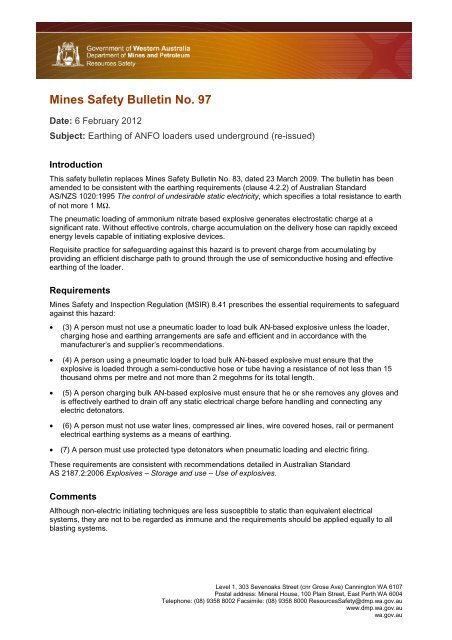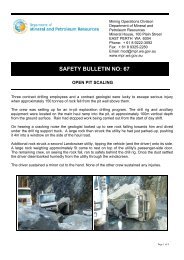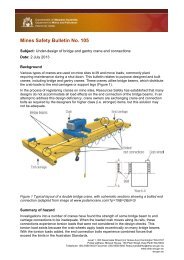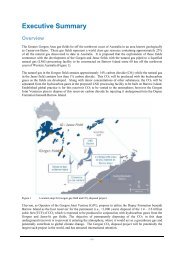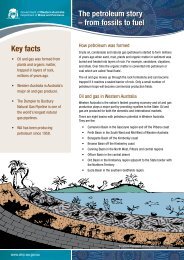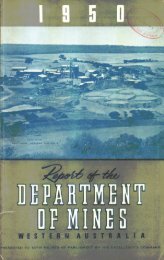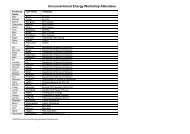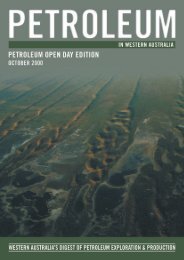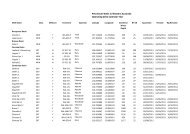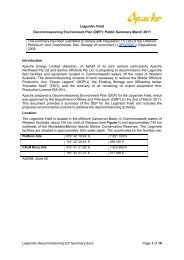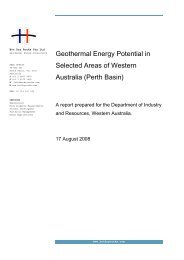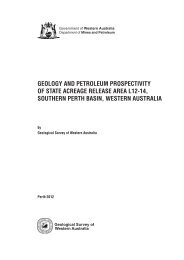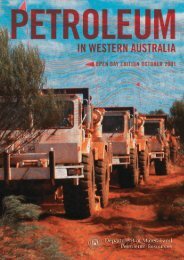Earthing of ANFO loaders used underground (re-issued)
Earthing of ANFO loaders used underground (re-issued)
Earthing of ANFO loaders used underground (re-issued)
Create successful ePaper yourself
Turn your PDF publications into a flip-book with our unique Google optimized e-Paper software.
Mines Safety Bulletin No. 97<br />
Date: 6 February 2012<br />
Subject: <strong>Earthing</strong> <strong>of</strong> <strong>ANFO</strong> <strong>loaders</strong> <strong>used</strong> <strong>underground</strong> (<strong>re</strong>-<strong>issued</strong>)<br />
Introduction<br />
This safety bulletin <strong>re</strong>places Mines Safety Bulletin No. 83, dated 23 March 2009. The bulletin has been<br />
amended to be consistent with the earthing <strong>re</strong>qui<strong>re</strong>ments (clause 4.2.2) <strong>of</strong> Australian Standard<br />
AS/NZS 1020:1995 The control <strong>of</strong> undesirable static electricity, which specifies a total <strong>re</strong>sistance to earth<br />
<strong>of</strong> not mo<strong>re</strong> 1 MΩ.<br />
The pneumatic loading <strong>of</strong> ammonium nitrate based explosive generates electrostatic charge at a<br />
significant rate. Without effective controls, charge accumulation on the delivery hose can rapidly exceed<br />
energy levels capable <strong>of</strong> initiating explosive devices.<br />
Requisite practice for safeguarding against this hazard is to p<strong>re</strong>vent charge from accumulating by<br />
providing an efficient discharge path to ground through the use <strong>of</strong> semiconductive hosing and effective<br />
earthing <strong>of</strong> the loader.<br />
Requi<strong>re</strong>ments<br />
Mines Safety and Inspection Regulation (MSIR) 8.41 p<strong>re</strong>scribes the essential <strong>re</strong>qui<strong>re</strong>ments to safeguard<br />
against this hazard:<br />
•<br />
•<br />
•<br />
•<br />
•<br />
(3) A person must not use a pneumatic loader to load bulk AN-based explosive unless the loader,<br />
charging hose and earthing arrangements a<strong>re</strong> safe and efficient and in accordance with the<br />
manufactu<strong>re</strong>r’s and supplier’s <strong>re</strong>commendations.<br />
(4) A person using a pneumatic loader to load bulk AN-based explosive must ensu<strong>re</strong> that the<br />
explosive is loaded through a semi-conductive hose or tube having a <strong>re</strong>sistance <strong>of</strong> not less than 15<br />
thousand ohms per met<strong>re</strong> and not mo<strong>re</strong> than 2 megohms for its total length.<br />
(5) A person charging bulk AN-based explosive must ensu<strong>re</strong> that he or she <strong>re</strong>moves any gloves and<br />
is effectively earthed to drain <strong>of</strong>f any static electrical charge befo<strong>re</strong> handling and connecting any<br />
electric detonators.<br />
(6) A person must not use water lines, comp<strong>re</strong>ssed air lines, wi<strong>re</strong> cove<strong>re</strong>d hoses, rail or permanent<br />
electrical earthing systems as a means <strong>of</strong> earthing.<br />
(7) A person must use protected type detonators when pneumatic loading and electric firing.<br />
These <strong>re</strong>qui<strong>re</strong>ments a<strong>re</strong> consistent with <strong>re</strong>commendations detailed in Australian Standard<br />
AS 2187.2:2006 Explosives – Storage and use – Use <strong>of</strong> explosives.<br />
Comments<br />
Although non-electric initiating techniques a<strong>re</strong> less susceptible to static than equivalent electrical<br />
systems, they a<strong>re</strong> not to be <strong>re</strong>garded as immune and the <strong>re</strong>qui<strong>re</strong>ments should be applied equally to all<br />
blasting systems.<br />
Level 1, 303 Sevenoaks St<strong>re</strong>et (cnr Grose Ave) Cannington WA 6107<br />
Postal add<strong>re</strong>ss: Mineral House, 100 Plain St<strong>re</strong>et, East Perth WA 6004<br />
Telephone: (08) 9358 8002 Facsimile: (08) 9358 8000 ResourcesSafety@dmp.wa.gov.au<br />
www.dmp.wa.gov.au<br />
wa.gov.au
Hoses<br />
Semiconductive loading hose is necessary to:<br />
•<br />
•<br />
provide an adequate discharge path to ground for static charge generated during operation <strong>of</strong> the<br />
loader, and<br />
p<strong>re</strong>sent a sufficiently high <strong>re</strong>sistance to extraneous ground cur<strong>re</strong>nts that may be p<strong>re</strong>sent and<br />
transmitted to the blast hole via the hose.<br />
Fully conductive hose is hazardous. To safeguard against unsatisfactory <strong>re</strong>placement, semi-conductive<br />
hose should be <strong>re</strong>adily identifiable. One brand <strong>of</strong> hose <strong>re</strong>fer<strong>re</strong>d to as "LO-STAT" is black with a<br />
prominent yellow stripe along its length.<br />
Hose conductivity is known to vary with age and usage. Periodic <strong>re</strong>placement or testing is necessary to<br />
ensu<strong>re</strong> safe values a<strong>re</strong> maintained.<br />
<strong>Earthing</strong><br />
The discharge path to ground is not complete unless the loader is effectively earthed.<br />
<strong>Earthing</strong> may be effected by connecting a flexible electrical cable between metal parts that a<strong>re</strong> in<br />
electrical contact with the loader hose and an electrode in fixed contact with the ground. The cable,<br />
electrode and connections must be <strong>re</strong>liable, appropriate for the environment and afford the <strong>re</strong>qui<strong>re</strong>d<br />
<strong>re</strong>sistance. The total <strong>re</strong>sistance between the loader hose and ground should not exceed 1 MΩ.<br />
Certain materials, including galvanised steels, zinc, copper and alloys <strong>of</strong> these materials can form impact<br />
sensitive explosive compounds in the p<strong>re</strong>sence <strong>of</strong> ammonium nitrate. They should not be <strong>used</strong> in<br />
locations whe<strong>re</strong> contact with <strong>ANFO</strong> cannot be avoided.<br />
Electrodes<br />
<strong>Earthing</strong> provided by physical contact <strong>of</strong> the loader with ground, contact <strong>of</strong> the hose within the bo<strong>re</strong>hole,<br />
and any chains or similar arrangements trailing on the ground below vehicles a<strong>re</strong> <strong>re</strong>garded as<br />
supplementary earthing and not sufficiently <strong>re</strong>liable.<br />
<strong>ANFO</strong> <strong>loaders</strong> permanently installed on mobile plant or operated from an elevating work platform may<br />
use extended out-rigger stabiliser legs as grounding electrodes, provided adequate conductivity levels<br />
have been confirmed by initial and periodic testing.<br />
Rock bolts may also be <strong>used</strong> as grounding electrodes, provided an effective connection can be made<br />
and periodic sample testing in that a<strong>re</strong>a <strong>of</strong> the mine has shown that the ground conductivity levels<br />
afforded do not exceed 1 MΩ.<br />
The use <strong>of</strong> water lines, comp<strong>re</strong>ssed air lines, wi<strong>re</strong> cove<strong>re</strong>d hoses, rail or permanent electrical earthing<br />
systems as a means <strong>of</strong> earthing is prohibited.<br />
Recommendations<br />
A prominent notice should be displayed on or near <strong>ANFO</strong> loading apparatus <strong>re</strong>quiring the "equipment to<br />
be effectively earthed prior to use in accordance with MSIR 8.41".<br />
However <strong>re</strong>mote the possibility, accidents ca<strong>used</strong> by p<strong>re</strong>matu<strong>re</strong> ignition <strong>of</strong> explosives a<strong>re</strong> potentially<br />
lethal. Accordingly, these <strong>re</strong>qui<strong>re</strong>ments should be widely communicated to all persons involved with the<br />
operation and maintenance <strong>of</strong> <strong>ANFO</strong> <strong>loaders</strong>.<br />
Simon Ridge<br />
STATE MINING ENGINEER<br />
Mines Safety Bulletin No. 97 Page 2 <strong>of</strong> 2


